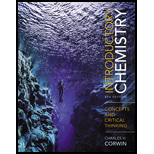
Concept explainers
(a)
Interpretation:
The given volume equivalent is to be stated.
Concept introduction:
Unit conversion is a method to convert a unit into another unit which has the same dimension. The unit conversion can be performed by dividing or multiplying a unit by a specific number. In some cases such as in the conversion of temperature units, a specific number is to be added.
(b)
Interpretation:
The given volume equivalent is to be stated.
Concept introduction:
Unit conversion is a method to convert a unit into another unit which has the same dimension. The unit conversion can be performed by dividing or multiplying a unit by a specific number. In some cases such as in the conversion of temperature units, a specific number is to be added.
Want to see the full answer?
Check out a sample textbook solution
Chapter 2 Solutions
Introductory Chemistry: Concepts and Critical Thinking Plus MasteringChemistry with eText -- Access Card Package
- What is the difference between (a) mass and density? (b) an extensive and an intensive property? (c) a solvent and a solution?arrow_forwardA group of students took turns using a laboratory balanceto weigh the water contained in a beaker. The results theyreported were 111.42 g, 111.67 g, 111.21 g, 135.64 g,111.02 g, 111.29 g, and 111.42 g.(a) Should any of the data be excluded before the average is calculated?(b) From the remaining measurements, calculate the average value of the mass of the water in the beaker.(c) Calculate the standard deviation s and, from it, the 95% confidence limit.arrow_forwardCalculate these masses.(a) What is the mass of 4.00 cm3 of sodium, density = 0.97 g/cm3 ?(b) What is the mass of 125 mL gaseous chlorine, density = 3.16 g/L?arrow_forward
- 8. Carry out the following conversions: (a) 1.42 lightyears to miles (a light-year is an astronomical measure of distance—the distance traveled by light in a year, or 365 days; the speed of light is 3.00x108 m/s), (b) 32.4 yd to centimeters, (c) 3.0 3x1010 cm/s to ft/s. With solutionarrow_forwardCalculate these masses.(a) What is the mass of 6.00 cm3 of mercury, density = 13.5939 g/cm3?(b) What is the mass of 25.0 mL octane, density = 0.702 g/cm3?arrow_forwardExpress the results of the following multiplications and divisions to the proper number of significant figures. All of the numbers are measured quantities. (a) 129.587 × 32.33 = 4.7791 (b) 3.21 × 5.793 10566.9 (c) 3.584 × 1029 (d) (5.247 × 10'3) × (1.3 × 10-17) =arrow_forward
- A metal object of an irregular shape has a mass of 31.5 grams. When the metal is added to water in a graduated cylinder, the volume of water increases from 5.28 mL to 7.61 mL. (A) How much water does the metal displace? (B) Calculate the density of the metal. (C) Is the metal made of platinum? Explain. (Hint: the density of platinum = 21.4 g/cm³)arrow_forward(a) A cube of osmium metal 1.500 cm on a side has a mass of76.31 g at 25 °C. What is its density in g/cm3 at this temperature?(b) The density of titanium metal is 4.51g/cm3 at 25 °C.What mass of titanium displaces 125.0 mL of water at 25 °C? (c) The density of benzene at 15 °C is 0.8787 g/mL. Calculatethe mass of 0.1500 L of benzene at this temperature.arrow_forward(a) The density of iron is 7.874g/cm^(3). Create two conversion factors from the density; (b) What is the volume of 38g of iron?arrow_forward
- Calculate these volumes.(a) What is the volume of 35 g iodine, density = 4.93 g/cm 3 ?(b) What is the volume of 33.28 g gaseous hydrogen, density = 0.089 g/L?arrow_forwardPrecious metals and gems are measured in Troy weights in the English system. Use the unit relationship given below to perform the requested calculations (A) what is the mass of 1.0 Troy ounces in grams? (B) The density of gold is 19.3g/cm^3. What is the volume of 12.5 carats of gold in mL? (C) a thief steals 531 pennyweights of silver. How many moles is that? (D) A wedding ring contains 2.56 x 10^22 atoms of diamond. How much are the diamonds in the ring worth if a 1-carat diamond costs $7600.0 ?arrow_forwardWhich quantity in each of the following pairs is larger? (a) 5.63 * 106 cm or 6.02 * 101 km(b) 46µs or 3.2 * 10-2 ms(c) 200,098 g or 17 * 101 kgarrow_forward
 Chemistry: Principles and ReactionsChemistryISBN:9781305079373Author:William L. Masterton, Cecile N. HurleyPublisher:Cengage Learning
Chemistry: Principles and ReactionsChemistryISBN:9781305079373Author:William L. Masterton, Cecile N. HurleyPublisher:Cengage Learning Chemistry & Chemical ReactivityChemistryISBN:9781337399074Author:John C. Kotz, Paul M. Treichel, John Townsend, David TreichelPublisher:Cengage Learning
Chemistry & Chemical ReactivityChemistryISBN:9781337399074Author:John C. Kotz, Paul M. Treichel, John Townsend, David TreichelPublisher:Cengage Learning

